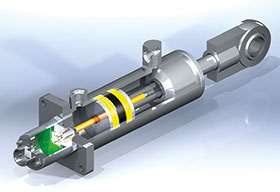

Variable inductance position sensors, known as linear variable inductance transducers (LVITs), have been around for several decades. Recent advancements in electronics and flexibility of package designs have made them cost-effective for mainstream in-cylinder applications.
This contactless technology offers many significant advantages regarding product life and long-term reliability over some competitive technologies and competes very favourably in performance with all competitors for specifications such as non-linearity, resolution and frequency response, but at a significantly lower cost. Equally important is the fact that LVIT sensors can typically withstand greater shocks and vibration, such as those commonly found in heavy industrial and mobile equipment applications for cylinders.
Linear variable inductance sensors operate by measuring the resonant frequency of an oscillator that uses a simple inductive probe. Its inductance is varied by the position of a conductive tube or gun-drilled rod that surrounds it. LVITs are typically offered in full-scale ranges from 4 to 900 mm. Both port-mounted and internally embedded packages are available, with either connector or cable terminations. These sensors produce an analog DC voltage or current output, with a digital output available for OEM applications.
Remote field calibration is a standard feature offered on LVIT variable inductance sensors. This feature permits a user to scale the analog output of the sensor after it has been installed in the cylinder. By merely grounding a wire to set the zero and full-scale output points, the sensor will give the desired full-scale output over its newly set range, making it unnecessary to scale the unit in an actual control system.
LVIT variable inductance sensors in cylinders offer a contactless position sensing solution that does not require machining a cavity in the cylinder piston for a ring magnet or wiper contact. In fact if an LVIT sensor were installed to replace an existing magnetostrictive sensor, the magnet could be left in place in the cylinder rod end without interfering with the inductive sensor’s basic operation.
In the past few years, requirements for instrumented cylinders in subsea applications have dramatically increased. Variable inductance sensors can be offered in a pressure-sealed version that allows a user to install the sensor and cylinder in a subsea environment at a depth of 3650 metres with 300 bar of internal hydraulic pressure.
Another application for LVITs similar to cylinder position sensing is spool position feedback for two-stage hydraulic valves. A short range (<2,5 cm) port-mounted LVIT sensor having its probe inserted into a blind hole in one end of the main spool is almost always an easier and lower cost installation than a pressure-sealed LVDT which requires an isolation tube to seal off its windings from the valve’s pilot pressure and which also needs relatively expensive electronics to operate it.
In summary, an LVIT position sensor has many advantages when used in a cylinder. Whether inserted into an O-ring port or embedded in the cylinder endcap, an LVIT features simplicity, needing just a deep hole in the piston rod. It offers excellent operating characteristics such as linearity, repeatability, stability, and temperature coefficient at a much lower cost than other sensors having the same general mechanical configuration. In addition, an LVIT is remarkably rugged and resistant to shock and vibration-induced failure. Furthermore, an LVIT has a very long service life because it works without any physical contact between the sensor probe and the bore of the deep hole, or without using an electrical contact that can wear out. Altogether these features make an LVIT the optimum choice for a broad range of fluid power position sensing applications, particularly for in-cylinder position sensing.
For more information contact John Matlack, Alliance Sensors, +1 856 727 0250, [email protected], www.alliancesensors.com

© Technews Publishing (Pty) Ltd | All Rights Reserved